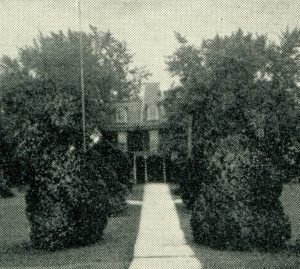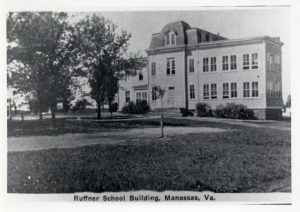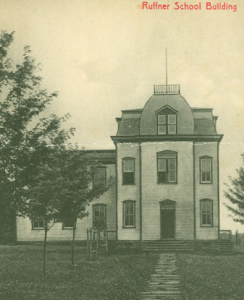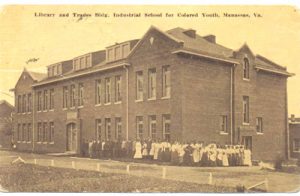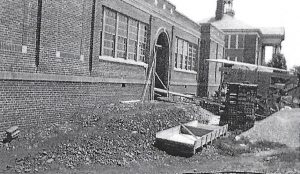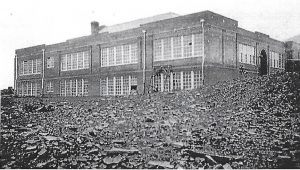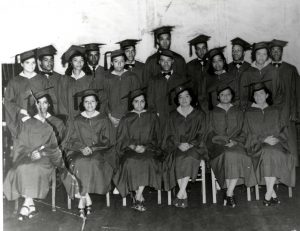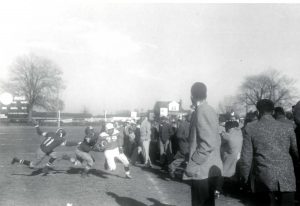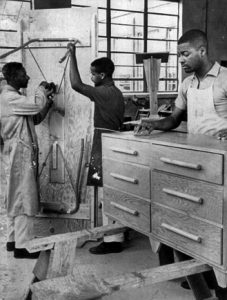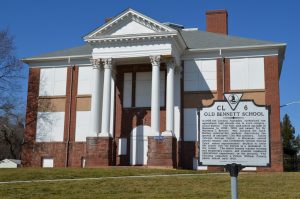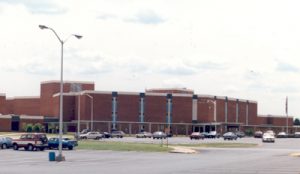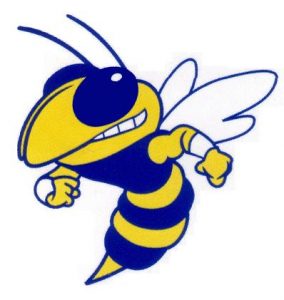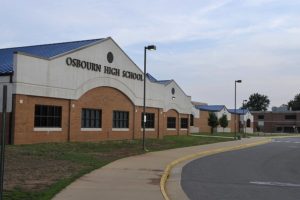A Detailed Look at the Schools
1880 Mr. John C. Weems recruited Miss Fannie Osbourn to be the private governess for his household. Miss Fannie, 23 year, was a Maryland native and came highly recommended by Maryland state education officials. A graduate of the Maryland State Normal School, Miss Fannie stayed in Manassas for two years before returning to her home in Prince George’s County, Maryland.
1888 Miss Fannie returned to the home of Mr. Weems where many families requested that she tutor their children.
1889 Miss Fannie opened up a private school known as the Hotel Annex, later known as the Goodwin House. Located on Main Street, the school was open to boys and girls.
1890 Miss Fannie moved her school to the Isaac Baldwin House located where the present day Manassas Museum is located. Miss Eugenia Osbourn, Fannie’s younger sister, moved to Manassas to assist in teaching at the school. Miss Eugenia, 23, had graduated from the Maryland Institute of Art with an art teacher’s training course.
1891 The school was re-named the Manassas Institute. The school prepared students for entry into college.
1893 The Manassas Institute was re-located to Center Street.
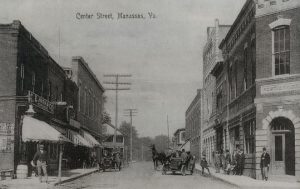
1894 Miss Jennie Dean, Prince William County former slave, opened Howland Hall, the first building and girls dormitory of the Manassas Industrial School for Colored Youth. Frederick Douglas delivered the dedication ceremony. Miss Dean spent almost ten years raising funds for the school after working off her father’s debt in Washington, DC. The land was bought from the Bennett family for $2,650.
This private institute would grow to encompass more than 100 acres with twelve buildings and a farm. It served black high school students from Virginia and other states. Students could learn normal training, agricultural, home economics, or trades.
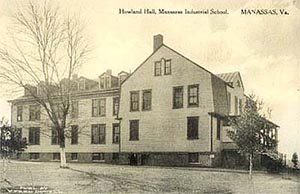
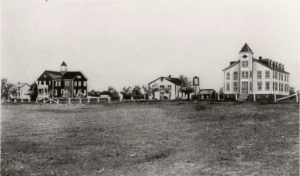
1896 With financial help led by Mr. George C. Round, former Union soldier and education advocate, the community raised funds for a new school. A local architect, Albert Speiden, designed the new school, built on Grant Avenue and facing Portner Avenue. Four girls comprised the first graduating class of the new Manassas Institute.
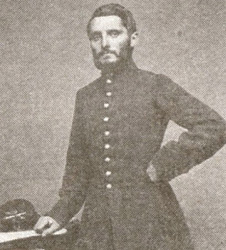
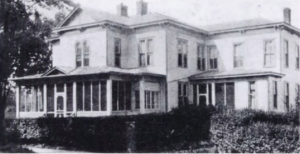
1898 With Eugenia’s help, the Manassas Institute began its journey to accreditation by several Virginia colleges. Graduates from the school often skipped the entrance exams for college because of the high standards of the Osbourn sisters.
1898 Miss Fannie married Mr. Murray G. Metz and became known as Mrs. Fannie Osbourn Metz.
1906 The Manassas Institute became part of the Virginia Public School System as the first high school located in Prince William County. The school served students throughout Prince William County and the Town of Manassas.
Mrs. Fannie was named the Principal and Miss Eugenia acted as the undesignated assistant principal and Mr. Round was the first School Board Chairman. Classes initially met in the Ruffner Building Number 1, named after William Ruffner, Virginia’s first State Superintendent. The Ruffner Building, built in 1872, was one of the state’s first public elementary schools and was located on present day Center Street and Peabody Street.
Enrollment was 27.
1907 Mr. Round secured grants that helped to create the agriculture and home economics departments in the high school. The grants also helped establish ‘a high school normal training’.
1908 After losing a campaign to have a ‘normal school’ built, Virginia selected the Manassas Institute to become the first of ten agricultural high schools in the state. Dr. Maitland C. Bennett, Mr. Round’s father-in-law, donated two acres of land for the school on what is now Lee Avenue across from the present day courthouse. Renamed the Manassas Agricultural High School, the school was also known as the Bennett School. The new building consisted of 9 rooms, a gym, an auditorium and a principals office. It cost $16,000 to complete.
The graves of two unidentified soldiers were found while building the school. Veterans from both sides of the Civil War met, Union soldier Mr. Round and Confederate soldier Mr. George Tyler, and they decided to continue building. In 1909, an elm tree was planted to mark the spot of the graves.
Due to a large elementary enrollment, high school classes were never held at the new school, except for normal or teacher trainings. Instead, the other high school classes, such as agriculture and college preparation, were held in an addition to The Ruffner Building located at the corner of Center Street and Peabody Street. The Ruffner building was expanded to house the growing number of high school students.
After some controversy, Mrs. Fannie became the Principal of the academic school, Professor H. Freeman Button headed the agricultural department of the school and Ms. Mary Moffitt headed the normal training.
The first graduating class had two members.
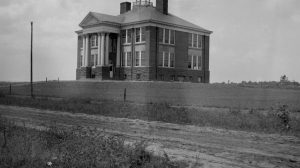
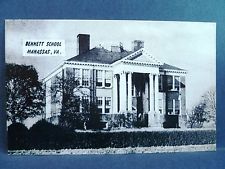
1910 Dr. Bennett sold ten acres of land for playgrounds and agricultural experimentation close to the Bennett School.
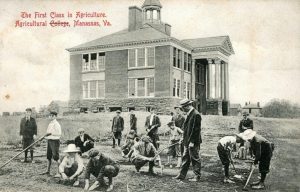
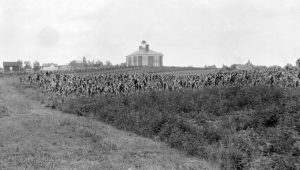
1911 Miss Eugenia led high school students to help commemorate the fiftieth anniversary of the First Battle of Manassas at the Peace Jubilee. President Taft attended the jubilee and the students presented “Pageant of the States.”
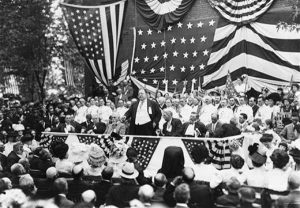
1912 Mrs. Fannie Osbourn Metz passed away and Miss Eugenia succeeded her as Principal.
The Manassas Industrial School for Colored Youth became known as The Manassas Industrial Institute.
1913 A further expansion of the Ruffner building allowed for manual training and an agricultural shop.
1913 Miss Jennie Dean passed away. By the time of her death, she had helped open 5 churches in the area and her school was teaching approximately 152 students a year.
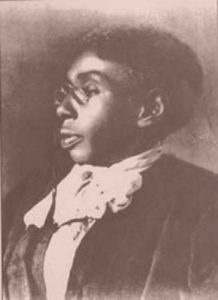
1914 The school became a member of the Southern Association of Colleges and Secondary Schools. It was one of the first schools in Virginia to be admitted.
1917 The school introduced commercial work, offered a commercial diploma and established the first version of a student council. Miss Williette Myers was head of this department.
1926 Because of overcrowding and a fear of losing accreditation, school administration authorized a new thirteen room brick high school to be built near the present day Courthouse on Lee Avenue and Peabody Street. It would be built on land next to the Bennett School bought from Dr. Bennett for $1,250. The school cost $55,000 to build. A proclamation from Prince William County supervisors during this year suggested that “as an expression of appreciation for a lifetime of service rendered” by both sisters that the building should be named after them.
1928 The new school opened and was renamed Manassas High School. It would serve only high school students on the western end of Prince William County because Garfield High School had opened on the eastern end of the county.
Enrollment was 203.
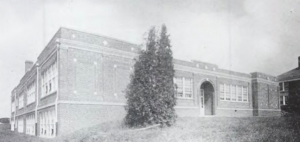
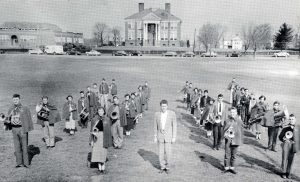
1930 The school system had the Ruffner building demolished.
1934 High school enrollment was 136.
1935 Miss Eugenia retired as Principal and stayed on as a librarian for the Manassas Ruffner-Carnegie library until 1943.
A newly established Student Cooperative Association, S.C.A., consisted of the Senate and the Council. The Senate was made up of three seniors, two juniors, one sophomore and one freshman. They made new rules, carried them out, and advised the administration of student infractions. The Council consisted of representatives from all classes, clubs and committees and they discussed problems and solutions of the school.
The Industrial Arts Department was formed.
1937 The Manassas Industrial School became a public school called the Manassas Regional High School. It served as the regional high school for black students in Fairfax County, Fauquier County and Prince William County. The three counties purchased 100 acres of land and the buildings from the school.
1938 The school system built a home economics cottage. It would become a residence for the Bennett School principal.
1939 Manassas High School was renamed Osbourn High School in honor of former Principal Eugenia Osbourn. The graduating class consisted of 50 students and was the largest to date.
1940 The school added showers.
1951 Miss Eugenia passed away.
1953 Osbourn High School moved to a new building located on Tudor Lane.

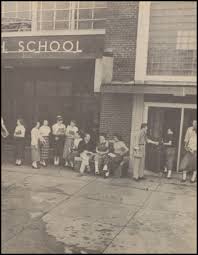
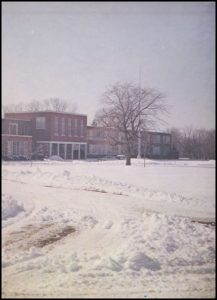
1954 Due to the Supreme Court case ‘Brown vs. the Board of Education’,the Manassas Regional High School would begin to teach only black students from Prince William County. It would serve high school students, as well as the elementary students from Brown Elementary. The school would be known as the Regional High and Elementary School.
1959 The Manassas Regional High and Elementary School closes and would be rebuilt as Jennie Dean HighSchool.
1960 The new Jennie Dean High School is opened and serves grades 1-12.
1966 Segregation ended throughout all the Prince William County Schools.
1960’s-1970’s The original buildings from the Manassas Industrial School for Colored Youth were demolished.
1970 The old Bennett School became the first Prince William County Police Department. It is now used for storage by the Police Department.
1975 Due to overcrowding, Prince William County built a new school on Euclid Avenue and closed OHS. The new school would be named Osbourn Park High School. This name was selected because residents fought to have a name that still honored Miss Eugenia and her contributions to the local school system. The OHS Yellow Jackets and royal blue and gold colors became the OPHS Yellow Jackets and colors.
Located between Manassas and Manassas Park, OPHS drew students from Manassas, Manassas Park and Prince William County from 1975-1977. Manassas and Manassas Park became independent cities during this year.
1977 Manassas students returned to the building on Tudor Lane under the previous name of Osbourn High School. The eagle was chosen as the mascot and navy blue and silver gray became the school colors.
Manassas Park students also left OPHS to attend their new school, leaving only Prince William County students at OPHS. Jennie Dean High School became a Junior High School for Manassas. 
1986 The school system demolished the old OHS building located on Lee Avenue.
1990 OHS became a three-year secondary school for grades ten through twelve after Grace E. Metz Junior High School opened and served grades seven through nine.
1995 The Manassas Industrial School and Jennie Dean Memorial opened on the school’s former site.
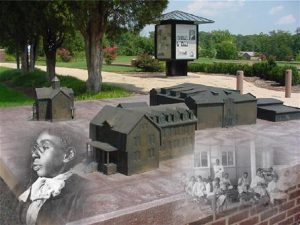
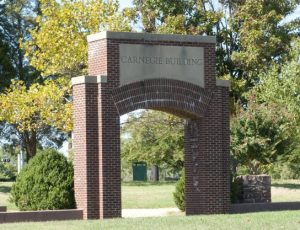
1999 OHS students moved a few feet over to their new school. During construction of the new school, builders kept additions built in the early and mid-1980’s. The badly deteriorated additions built in the 1950’s and 60’s were torn down.
2000 OHS became a four year school again.
2014 OHS’s Joseph B. Johnson Wing reopened with 10 additional classrooms. It had been the science wing in the 1980’s and after that, the Johnson Learning Center for the alternative education.
